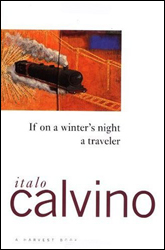 From the back cover:
From the back cover:
“If on a winter’s night a traveler turns out to be not one novel but ten, each with a different plot, style, ambiance, and author, and each interrupted at a moment of suspense. Together they form a labyrinth of literatures, known and unknown, alive and extinct, through which two readers, a male and a female, pursue both the story lines that intrigue them and one another. They are the true heroes of the novel, for what would writing be without readers?”
My thoughts:
In this metafictional masterpiece, Italo Calvino draws the reader (that’s you) into a bizarre novel that folds in on itself, lying on the page but beyond it. It is a communication between the author and the reader—mediated by the publisher, by the translator, by academics, by government censors, by political movements, by the other reader, and finally by the author and the reader themselves. It is the ultimate exercise in literary self-reflection.
I marvelled continually at Calvino’s genius and there were several passages I loved (including the famous opening chapter in which he anatomises the process of choosing one book to read among the thousands contained in a bookstore). I also had a feeling of discomfort (I don’t know any other way to label it), that is familiar from other Cold War period novels (I’m not sure that the cause has anything to do with the Cold War itself, it’s just a convenient shorthand for the post-WWII to the mid-eighties), like Next Episode and Pale Fire (and even The Fire-Dwellers and St. Urbain’s Horseman). Perhaps I’ll figure out exactly what that is at some point.
Though there is some humour here (mostly of the absurdist variety), this is no light-hearted puzzle. It’s a puzzle that requires considerable concentration and focus to absorb, and time to contemplate it afterward.